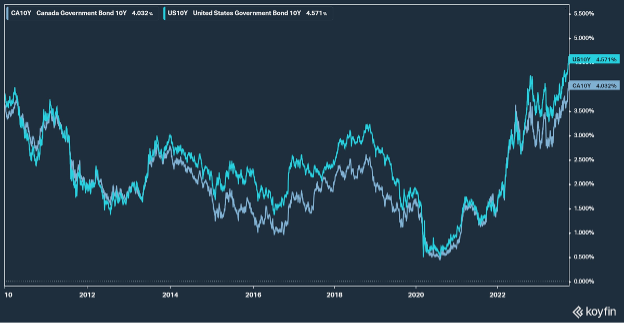Q3 2023 Market Commentary: Interest rates look to be staying higher for longer
by Vittorio Ciccone | M.Sc | Louisbourg Investments
Q3 Market Recap: Interest rates look to be staying higher for longer Low unemployment rates persist, and inflation continues to run higher than central banks’ targets.
Meanwhile, concerns over the US regional and global banking failures eased as central banks and governments stepped in to help. President Biden and Congress reached an agreement to suspend the debt limit until January 2025.
In these last three months of 2023, the bullish sentiment is fading. Instead, the higher for longer narrative is taking hold across major markets.
This change comes in direct response to the fixed-income markets offering the highest level of yields in over 15 years. All curves indicate yields continuing to tick higher.
Meanwhile, even with the US Federal Reserve and other central banks being far from a strategy pivot, the bond market appears to be heading into a third year of negative returns.
Commodities, however, have proved a notable outperformer. With production cuts from Saudi Arabia and Russia, energy has made gains.

Figure 1: Yields through September 30, 2023
Below, you’ll find Q3 commentary from Louisbourg Investments’ Mathieu Roy, CFA Head of Equities,and Heather Hurshman, Head of Fixed Income. Please feel welcome to email Ciccone McKay, info@ciccone-mckay.com, with any questions – a member of the team will help you straightaway.
Mathieu Roy, CFA on Equity Markets
Investors have transitioned from cheering to fearing a resilient economy. Equities were once again delivering solid quarterly gains despite monetary conditions meant to slow down the economy. Those gains evaporated in the last few weeks of September. We believe the enthusiasm had been built on a resilient economy, some progress on bringing down inflation and some productivity that could be brought to the forefront by technology advancement in the form of artificial intelligence. This thematic is being challenged by the possibility of higher for longer as interest rates may stay elevated to create slack in the employment market and to mute wage gains. Equities broadly finished the quarter with small negative returns.
Canadian equity quarterly gains evaporated by mid September. Canadian equities did benefit from a booming oil price, which moved $20 higher in three months to close out the quarter above $90 a barrel. This helped the important energy sector generate a healthy 10% return for the period. Unfortunately, the only other positive return was generated by the immaterial Health Care sector. This was not enough to bring the S&P/TSX Composite in positive territory (-2.2%) as all other nine sectors were in the red for the period. Interest sensitive sectors stood out negatively as interest rates moved higher. Communications (-13%) and Utilities (-12%) were the worse performers. Cyclically sensitive sectors such as Technology (-8%) and Consumer Discretionary (-7%) also trailed.
US equities also posted a negative return in the third quarter. Overall, US equities closed the quarter down -3.3% in USD. Currency movements had a positive impact on performance with US equities down -1.2% in Canadian dollar. Looking on a sectorial basis, the impact of higher interest rates was most notable for Utilities (-9%), Real Estate (-9%), Consumer Staples (-6%) and Technology (-6%), which all underperformed the benchmark. In contrast, Energy (+12%) emerged as the standout winner, benefiting from a significant upswing in commodity prices.
International equities closed the quarter down -2.0% in CAD, similar to their North American counterparts. Currency movements had a slight negative impact on performance, due to the strength of the Canadian dollar compared to other major benchmark currencies. Looking on a sectorial basis, the impact of the higher interest rates was most notable for Technology (-9%) and Utilities (-7%), both of which underperformed the benchmark. In contrast, Energy (+14%) emerged as the standout winner, benefiting from a significant upswing in commodity prices. Financials (+3%) also performed well with Japanese banks leading the way as investors grew more optimistic about the Bank of Japan potentially abandoning its yield curve control policy.
Investors had been persistently more excited by the Fed pausing than worried about the added burden that monetary tightening will have on the economy. Central banks are intent on fighting inflation. Nice progress has been made but wage inflation continues to be sticky. We do not believe investors had been giving enough weight to a scenario where interest rates stay elevated for an extended period.
We believe that business conditions are likely to continue to get more difficult for companies and equity markets are not discounting this enough. In the mid-term, easier money is likely to come back as the economy weakens and inflation softens, making conditions attractive for equities. Given the circumstances, we believe the risk-reward proposition is only fair at this point and that investors should hold a neutral to slightly underweight equity allocation based on their respective investment policies. We currently prefer Canadian and US equities given that international equities need to deal with specific long term secular challenges and near-term headwinds related to Russia’s attack on Ukraine.
Heather Hurshman, on Fixed Income Markets
Central Banks were relatively quiet this quarter, echoing message of “higher for longer” and “staying the course.” Financial markets, on the other hand, were not as subdued as 10 year bond yields moved 75 basis points higher and equity markets saw a retracement of 6-9% in value. The quarter proved to be a reality check for the bond market where the “higher for longer” rhetoric was finally heard as the economy has proven to be resilient to the rapid rise in interest rates. A number of other catalysts also contributed to the strength of a bond sell off this quarter, including a downgrade by Fitch to the US credit rating, citing “expected fiscal deterioration over the next three years”, the 50 basis point increase in the 10 year yield under yield curve control by the Bank of Japan, the newly announced increase to US Treasury bond issuance due to larger fiscal deficits where the additional supply will increase the monthly ten and thirty year Treasury auction sizes by 17-28%. Other factors exacerbating the move to higher longer term bonds yields has been the widespread absence of buyers as the four largest buyers of US Treasuries have stepped back, including, QT by Fed Reserve, China down 17%, Japan and domestic chartered banks. All of these forces, individually and then combined together, contributed to the dramatic rise in global bond yields.
On Sept 6, 2023, the Bank of Canada held their overnight lending rate steady at 5%. Headline inflation in advanced economies has been declining, however, the core component of inflation remains high. Global growth slowed in Q2/Q3 2023 largely due to the economic slowdown in China and reduced manufacturing activity. In contrast, US GDP growth continues to surprise to the upside, led by the consumer. Canada has entered a period of weaker economic growth, where Q2 GDP contracted by .2%, reflecting weaker consumption, a decline in housing activity, and the devastating wildfires and weather events across regions in Canada. This recent weakening in economic growth should help alleviate pricing pressures in some segments. The headline CPI rate in Canada is currently 4% y/y, with Core CPI at 4.1% y/y. The labour market remains strong with 100k of new jobs created in August and September. The upward trend in employment continues to be supported by the highest rate of population growth since 1957, this time, largely due to immigration.
Despite this, the labour market remains tight with wage growth of 4-5% and a low unemployment rate of 5.5%.
During the third quarter of 2023, bond yields rose steadily, led by higher thirty-year bonds and a re-steepening in the yield curve. Over the period, two-year Canada bond yields increased 29 basis points to 4.87%, while five-year yields increased 56 basis points to 4.25%. The ten-year Canada yield increased 75 basis points to 4.02%, while thirty-year yields increased 71 basis points to 3.81% over the same period.
Conclusion
A key takeaway from the above commentaries is, as noted at the start, the higher for longer expectation across the markets. Global yields, particularly the US 10-year, are an important metric for the pricing of many other assets: mortgages, discount rates, etc.
As such, with rates being held higher for longer, we anticipate continued volatility across other asset classes. Ultimately this should lead to an economic slowdown — exactly what global central banks want.
During this period of higher rates you may experience increased volatility within your portfolio. Ciccone McKay’s professional advisors can equip you with the tools you need to properly navigate this climate – not just for years like 2023, but for all your future years of financial planning.
As always, for more information about Ciccone-McKay Financial Group, or if you want to chat with someone at the firm, we welcome your call: 604-688-5262.

